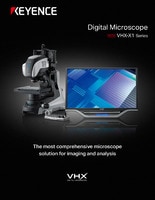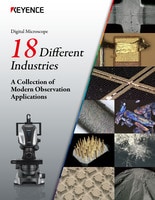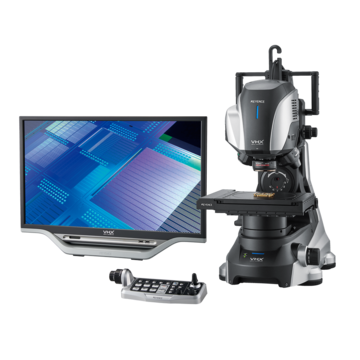Digital Microscopes
Observation and Analysis of Bubbles, Chocolate Bloom, and Other Appearances Affecting Food Quality
Variations in food texture and flavor can cause repeat customers to stop trusting the product or to make complaints about it.To prevent these problems, food manufacturing always needs to provide consumers with stable quality in texture and flavor. Quality that adds value to food can be evaluated by observing and analyzing its appearance (for example, bubbles and ingredient crystals).
This section explains the importance of magnified observation and analysis of food. This section also introduces the latest examples of observation and analysis using our 4K digital microscope, such as observation and automatic analysis of gas cells in bread and chocolate bloom observation, which were difficult until now. These examples show how quantitative evaluation is now possible with simple operations.
Food Quality Evaluation by Appearance Observation and Analysis

It is extremely difficult for inspectors to use their senses to frequently evaluate textures and flavors of mass-produced foods. Quality preservation through quantitative evaluation is difficult at most manufacturing sites and can even be said to be impractical because it is difficult to secure inspectors having sensory testing skills and inspection results can vary from inspector to inspector and from day to day.
Therefore, it is effective to quantitatively evaluate food conditions, such as texture, flavor, and quality, by closely observing and analyzing the food appearance using microscopes. The following are examples of food quality evaluation based on microscopic appearance, shapes, measured values, and other related factors.
Bread and cakes
Melting and smooth textures in the mouth can be compared and evaluated by observing and analyzing the conditions of gas cells on cross sections of bread, bread doughs, cakes, and similar foods.
Chocolates
The appearance of solid chocolates is observed while they cool. In the manufacturing process, the appearance is checked to find whitish coating (or bloom*), which forms when certain ingredients melting in the chocolate cool and solidify on the surface.
Chocolate with lower surface roughness has better mouthfeel and melting texture. Because the surface roughness is affected by temperature after shipment, the surface roughness is controlled for the target season in the case of some seasonal products.
Tips:What is chocolate bloom?
Chocolate bloom is a coating on chocolate. Some ingredients melt at certain temperatures and rise to the chocolate surface. Bloom forms, like flowers bloom, when these ingredients solidify and crystallize on the cooled surface. There are two types of chocolate bloom—fat bloom and sugar bloom. Fat bloom forms when fat melting in cocoa butter rises to the surface and solidifies. Sugar bloom forms when melting sugar rises to the surface and solidifies.
Note that too much bloom gives chocolate an overall whitish color, which impairs not only its appearance but also its flavor.
Noodles and pasta
Smooth mouthfeel and the feeling when food is swallowed can be checked and evaluated by observing surface irregularities on noodles using a microscope.
The core conditions (water displacement) can also be checked by observing cross sections of noodles, which is effective in determining the appropriate boiling time. Additionally, observation and analysis of air bubbles in noodles can be used to determine freeze-drying conditions as well as to check the texture and boiling time.
Frozen foods including meat and fried foods
Frozen foods, such as hamburger patties, chicken tenders, and chicken cutlets, can be evaluated by checking the binding conditions between the meat and coatings. During freezing and defrosting, these conditions may change.
The crispy texture of fried food coatings can be evaluated by quantifying three-dimensional surface irregularities.
Beef
Meat tenderness can be evaluated by observing simmered or roasted meat fibers. Additionally, textures can be evaluated by checking differences in the tissue shape and surface roughness caused by differences in factors such as content ratios of ingredients.
Ham and sausages
Changes in texture may be evaluated by observing changes in meat tissues before and after freezing and by quantifying analyzed ratios of ingredients.
Tofu, soymilk, and similar foods
The processing quality can be evaluated by observing and analyzing air bubbles (porosity) in cross sections. Smoothness can be evaluated by analyzing proteins.
Sake and other alcoholic beverages
Mouthfeel and the feeling when beer is swallowed can be evaluated by measuring and quantifying the shape of gas bubbles in beer.
Some sake breweries visualize and quantify the core of sake rice to determine the quality of rice suitable for brewing daiginjo, sake made with rice of which at least 50% of the outer layers are polished away, and the precise polishing amount.
As introduced above, the quality of food, such as its texture and flavor, can be evaluated by observing and analyzing its appearance.
Read on for introductions to examples of the improvement of sophistication and efficiency of food observation and analysis using our 4K digital microscope.
Get detailed information on our products by downloading our catalog.
View Catalog

Examples Observing and Analyzing Food Textures and Quality
Processed foods come in a wide range because they use various ingredients having different light reflectance and absorptance and have three dimensional and complex shapes. Therefore, it is difficult to determine observation conditions and to adjust the focus, so these operations take a lot of time and effort. Visual analysis also has the problem that human errors in values hinder quantitative evaluation.
KEYENCE has developed a next generation microscope that solves various problems arising from magnified observation and analysis using microscopes, improving the sophistication and efficiency of these operations.
Observation of gas cells in bread dough
The VHX Series 4K digital microscope combines high resolution with a depth of field that is at least 20 times larger than optical microscopes, enabling observation of three-dimensional targets.
The Multi-lighting function automatically obtains data of multiple images captured under omnidirectional lighting at the press of a button, enabling prompt observation simply by selecting the image suitable for the purpose. This significantly reduces time and effort required for condition determination.
Additionally, when an operator simply selects a past image, the conditions used for capturing that image are fully reproduced, allowing for observation under the same conditions even when the sample is observed on a different day by a different operator.

Multi-lighting (20x)
Observation of gas cells in bread dough using the VHX Series 4K digital microscope
Automatic analysis of gas cells in bread dough
The VHX Series is capable of performing automatic area analysis on gas cells in bread dough.
Binarization can be performed at arbitrary thresholds using the automatic area measurement/count function. This function automatically measures and calculates detailed values—such as the average area, standard deviation, maximum value, minimum value, area ratio, and other items of gas cells in a selected area as well as the accurate count, area, perimeter, maximum diameter, and minimum diameter of gas cells—and then displays these values in a list. This function quantifies the analysis results, eliminating variations in evaluation.
Additionally, the results can be output to Excel for instant report creation.

Multi-lighting illumination (20x) + Automatic area measurement/count
Automatic analysis of gas cells in bread dough using the VHX Series 4K digital microscope
Observation of chocolate bloom
The VHX Series 4K digital microscope can capture clear 4K images of chocolate bloom for observation even at high magnifications.
Observation can be difficult when the food surface has low contrast between the normal part (the background) and the chocolate bloom (the observation target). The VHX Series can observe these targets with high contrast thanks to the High Dynamic Range (HDR) function, which captures multiple images at varying shutter speeds to obtain an image with high color gradation.
It is also difficult to observe the entire bloom on a three-dimensional chocolate at high magnifications using conventional microscopes because only a part of the chocolate bloom can be brought into focus. The VHX Series is equipped with the depth composition function, which composes multiple images having different focus positions. This function can generate an image fully focused on the entire field of view even when the target has large height differences, enabling clear observation of the entire target.
With a wide range of functions for image capturing and processing, even chocolate bloom can now be observed easily and quickly at high magnifications using clear 4K images.

Ring illumination (500x)
Observation of chocolate bloom using the VHX Series 4K digital microscope
We’re here to provide you with more details.
Reach out today!

A 4K Digital Microscope That Improves the Efficiency of Food Texture and Flavor Evaluation Based on Appearance
Many foods are difficult to observe and analyze, conventionally requiring much time and effort in proportion to this difficulty.
The VHX Series 4K digital microscope provides high performance and functions that are accessible with simple operations, enabling clear observation and imaging.
Equipped with many other functions, the VHX Series can be used for a wide range of applications in the food industry such as observation and analysis of emulsion, crystals, and microorganism.
For additional info or inquiries about the VHX Series, click the buttons below.
Get detailed information on our products by downloading our catalog.
View Catalog




